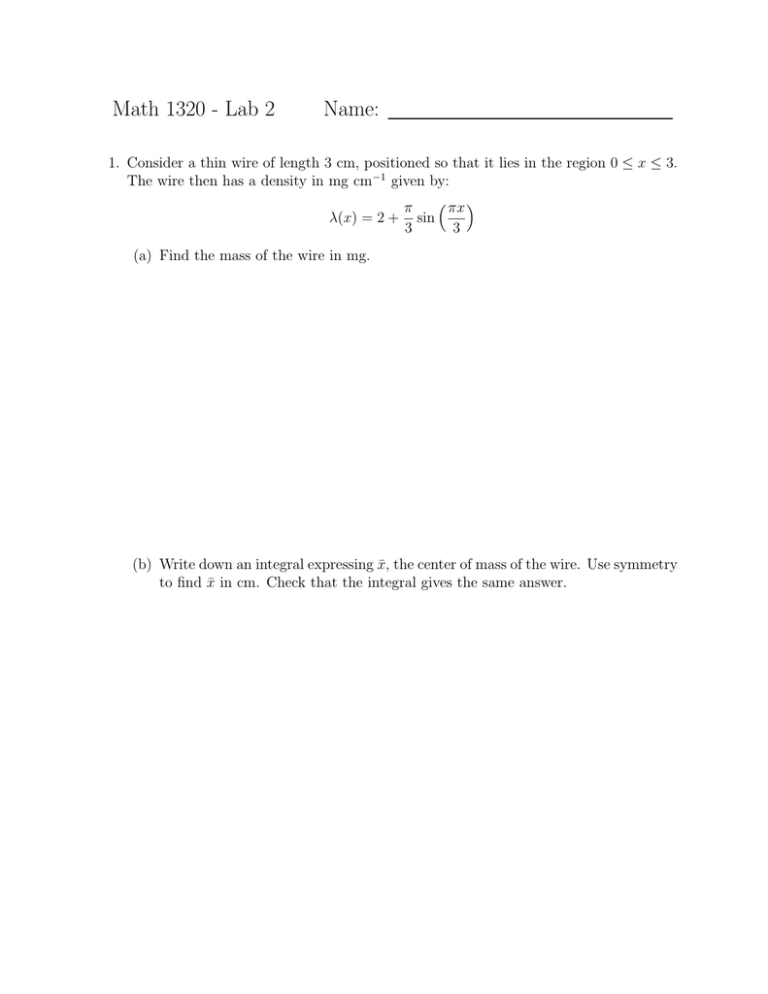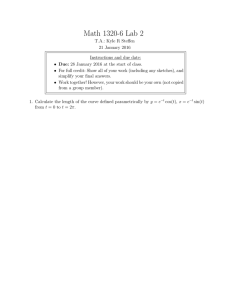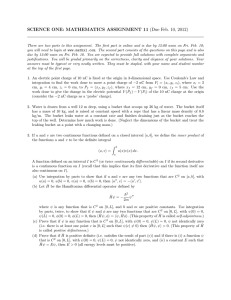Math 1320 - Lab 2 Name:
advertisement

Math 1320 - Lab 2 Name: 1. Consider a thin wire of length 3 cm, positioned so that it lies in the region 0 ≤ x ≤ 3. The wire then has a density in mg cm−1 given by: πx π λ(x) = 2 + sin 3 3 (a) Find the mass of the wire in mg. (b) Write down an integral expressing x̄, the center of mass of the wire. Use symmetry to find x̄ in cm. Check that the integral gives the same answer. 2. Suppose that you are gathering water from a well by pulling a rope attached to a bucket of water. As the force of gravity FG acts on the bucket, this requires a work W given by Z d W = FG (y)dy 0 where d = 7 m is the depth of the well and y = 0 corresponds to the bottom of the well. If the mass of the rope is negligible, the force of gravity on the bucket is given by FG (y) = m(y)g, where g = 9.81 m s−2 and m(y) is the mass of the bucket. (a) Suppose that the mass of the bucket is constant, m(y) = 5 kg. Find W . (b) Now suppose that the bucket has the same initial mass m(0) = 5 kg, but is continuously leaking so that its mass is reduced by a constant rate of 0.25 kg for every meter it is raised. Find m(y) and W . Page 2 3. Imagine a body moving along the x-axis from a to b while a force F (x) acts in the x-direction. In general the work done by the force is given by an integral. Z b F (x) dx W = a So unless F (x) is constant, we cannot use the simple formula W = F d where d is the displacement from a to b. (a) If Fave is the average force acting between a and b, show that W = Fave d. (b) Use part (a) to calculate the average force on the bucket in problem 2 part (b). Page 3 4. Consider a right circular cone of mass 1 kg with height 2 cm and base radius 1 cm. Suppose we orient the cone upwards so that it points in the z-direction and its base is centered at x = y = z = 0 cm. Suppose that the cone is made from a mix of different metals with different densities, so that the density ρ(z) in kg cm−3 is given by: ρ(z) = 4k π(3 − z)(2 − z)2 (a) Find k. Hint: the density is constant on any horizontal cross-section. (b) We can argue by symmetry that the x and y coordinates of the center of mass are x̄ = ȳ = 0 cm. Find the center of mass in the z-direction, z̄. Page 4




